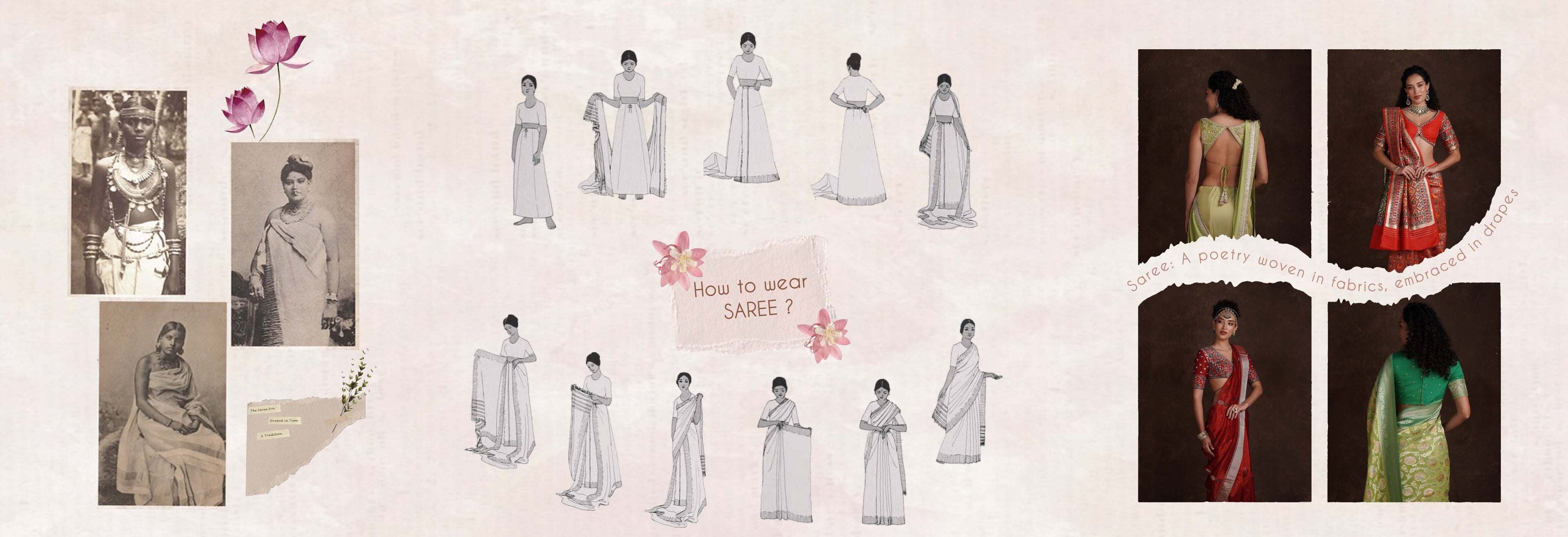“Saree: A poetry woven in fabrics, embraced in drapes”
A saree is a long piece of unstitched fabric, typically 5 to 9 yards long, draped around the body. India is the only country in the world that flaunts this elegant and graceful 9 yard attire with so much ease and inspires other countries to try it occasionally. The saree is much more than a humble piece of clothing, for its roots goes back to the Indus Valley Civilization, where women wore unstitched long fabrics casually draped around their body. Later with British colonialism in India the garment started evolving and the 3pc set (a blouse(choli), a saree and a petticoat) came into existence.
Every saree has a story to tell and that can be seen through the ‘ancient paintings of women wearing sarees,’ ‘carvings of women wearing sarees,’ ‘textbooks mentioning the birth of sarees.’ Today, saree is not only about patterns, fabrics and designs but also how you wear it and how you carry it. Traditionally there are popular 21 draping styles but modern designers and celebrity saree drapers can drape sarees in more than 350 styles.
If you have never worn a saree do not get intimidated because we have listed down the step by step process to wear a saree.
Choosing the right fabric and length is very important as it will make the whole process a lot easier, smooth and easy to carry. Fabrics like cotton, silk are best to start with because they are lightweight and breathable. A 6 yard saree is widely used because it is easy to wrap and walk around, whereas a 9 yard saree is often used for traditional and ceremonial activities.
Things you need for saree draping:
-
Well fitted petticoat/shapewear
-
Safety pins
-
Saree pins
Step by step process to wear a saree:
Preparation:
Wear a blouse and petticoat. Tie the petticoat at your waist so the saree has something firm to tuck into.
Step 1: Tuck the saree in the petticoat
Tuck the end of the Saree in front below your navel into the petticoat and take a full turn.
Step 2: Start making the pleats
Hold the saree at this tucked-in end and start to make your pleats. Try making 5-6 pleats depending on the length of the fabric. The pleats should be 4-5 inches wide. Keep folding the pleats into the left till you get 5-6 pleats.
Step 3: Tuck the pleats inside the petticoat
Take the pleats carefully and tuck it inside the petticoat just to the left of your navel.
Step 4: Make the other end of the fabric as long pallu
Bring the remaining fabric (the Pallu) over your left shoulder from behind and take it over your left shoulder.
Step 5: Let the pallu fall freely or in pleats
Adjust accordingly and let the pallu fall freely or pin it into pleats with a hidden safety pin. This depends on if you want a free flowing pallu or a pleated one.
Step 5: Smooth the lower drape
Ensure the hemline is even, and add one safety pin where the pallu crosses the left bust for easy walk and you are done.
Importance Of Wearing a Saree Properly:
-
It is a sign of respect to Indian culture.
-
A properly draped saree enhances a woman's grace and gives her a dignified presence.
-
Wearing a saree properly instils a sense of confidence.
Pro Tips for Beginners:
-
If you are wearing heels, wear it before draping the saree as it will give a good length to the saree.
-
Pre pleat the pallu for a neater, cleaner look. It will help fasten the saree draping process.
A saree is the most elegant piece of Indian clothing, radiating feminine energy and grace. Wearing a saree can feel overwhelming at first but once you get the hang of it there is no going back. You can experiment with different types of saree draping styles and pallu styles for making a statement wherever you go. There are multiple pallu designs which you can choose from depending on the occasion, the saree design, the fabric and your comfort. We have a vast collection of all traditional, modern and fusion styles of sarees at tajore.com and you can visit our store in Malad West, Mumbai for an exclusive experience.





